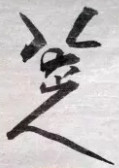Bada Shanren
| Bada Shanren | |||
|---|---|---|---|
| Chinese | 八大山人 | ||
| Literal meaning | Mountain Man of the Eight Greats | ||
| |||
| Birth name | |||
| Chinese | 朱耷 | ||
| |||


Bada Shanren (Chinese: 八大山人; pinyin: Bā dà Shān rén; c. 1626–1705), born Zhu Da (Chinese: 朱耷; pinyin: Zhū Dā), was a Han Chinese painter of ink wash painting and a calligrapher. He was of royal descent, being a direct offspring of the Ming dynasty prince Zhu Quan who had a feudal establishment in Nanchang. His master lineage's accession was revoked following the last King Zhu Chenhao's rebellion in 1521, but the rest of the lineage was allowed to retain status in Jiangxi. Art historians have named him as a brilliant painter of the period.
Life and work[]
Bada Shanren, a purported child prodigy born to a handicapped father, began painting and writing poetry in his early childhood. About the year 1644,[1] when the Ming emperor committed suicide and the Manchu army from the north attacked Beijing, the young Han Chinese man sought refuge in a vihara. Because he was a Ming prince, the dynastic upheaval created a great amount of uncertainty for his position in society. As years passed and the Manchurian court became more firmly established, there was less and less insecurity among the Qing regime about remaining Ming loyalties and possible future rebellions. Due to these more stable circumstances, after 40 years, Bada Shanren deemed it acceptable to leave the monastery and to re-enter day-to-day life among society.[2] In the aftermath of a nervous breakdown that could have been staged to avoid retribution for his family background, Zhu Da abandoned his monastic life and developed a career as a professional painter, adopting a series of descriptive pseudonyms, most notably Bada Shanren by which he is most often known today. He is said to have screamed and made weird sounds while painting.[3] The stylized vertical writing of his pseudonym Bada Shanren (八大山人) looks like the characters for laugh (笑) and cry (哭), thus by signing his paintings he implied his confusion and feelings of grief for the fate of his country and home.[4]
His paintings feature sharp brush strokes which are attributed to the sideways manner by which he held his brush. In the 1930s, Chinese painter Zhang Daqian produced several forgeries of Bada Shanren's works but they are easily spotted by the trained eye, because the modern copies were softer and rounder.
Yale University scholar Fred Fangyu Wang (1913-1997) and his wife Sum Wai(沈慧) were major collectors of Bada Shanren paintings from the 1960s until 1997 when Fang passed away. They had amassed the largest private collection of Bada Sharen's works, including paintings and calligraphies. during their lifetimes. The Freer Gallery of Art later bought the collection from their estate. Freer is currently the holder of the largest collection of Bada Shanren's art in the United States.[5]
Gallery[]

Two Birds, Sen-oku Hakuko Kan, Kyoto, Japan

Metropolitan Museum, New York

National Palace Museum, Taipei, Taiwan

Nelson Atkins Museum, Kansas city, USA
References[]
- ^ Simply see Chinese wiki
- ^ Glaze, Anna. Landscapes, Tradition, and the Seventeenth-Century Art Market: A Different Side of Bada Shanren. Master's Thesis, University of California, Davis., June, 2008.
- ^ Stockard, Marilyn
- ^ China: five thousand years of history and civilization. Hong Kong: City University of Hong Kong Press. 2007. p. 761. ISBN 978-962-937-140-1.
- ^ Cotter, Holland (2015-08-13). "Review: Bada Shanren, Chinese Art Superstar, Takes a Bow at the Freer (Published 2015)". The New York Times. ISSN 0362-4331. Retrieved 2021-01-26.
- Stokstad, Marilyn; Art History, 2011, 4th ed., ISBN 0-205-79094-1
External links[]
- Zhu Da and his Painting Gallery at China Online Museum
- Could Bada Shanren be the first caricaturist in China?
| Wikimedia Commons has media related to Bada Shanren. |
- 1626 births
- 1705 deaths
- Ming dynasty painters
- Qing dynasty painters
- People from Nanchang
- Painters from Jiangxi
- Ming dynasty calligraphers
- Qing dynasty calligraphers
- Qing dynasty Buddhist monks
- 17th-century Chinese calligraphers
- Buddhist artists
- 18th-century Chinese calligraphers
- 17th-century Chinese painters



